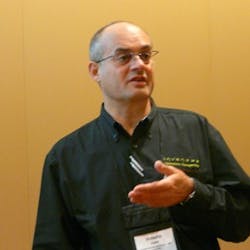Life Sciences Business and Production Models Seeing Major Change from Collaboration into Ecosystems
"Not very long ago," said presenter Jonathon Thompson, life sciences manager, Invensys Operations Management, "pharma and life sciences products were a matter of individual breakthroughs-the era of sales of blockbuster drugs. Most products were sold, not to patients, but to physicians and hospitals. A major change happened in the last couple of years, to a collaborative model."In this collaborative model, manufacturers are reaching out to a much wider universe of buyers and influencers, including insurance providers, healthcare researchers and universities, and in general, a broadened horizon of people both to keep informed and to understand market offerings."And we're on the cusp of an even bigger change: an age of ecosystems," Thompson said. "The universe is undergoing a dramatic expansion to include service providers, retail chains, government, analogous food and beverage products-nutriceuticals among them-and to patients around the world."With the demise of blockbuster drugs, producers have shifted emphasis from high-risk, potentially high-return research and development to production cost containment. "If you think of this as three boxes, one of R&D, one of production and one of patients, in the blockbuster era, R&D and patients were huge and production was just a little black box. In an era where costs are paramount, that little black box has to very quickly grow to a gigantic size, and it has to become a lot more transparent," Thompson explained.Presenter Roberto Zerbi, Global Industries Solutions, Life Sciences director, Invensys Operations Management, continued: "We think that a blueprint approach offers a viable solution for this base set of changes. Invensys has established sets of blueprints with measurable specifications. For example, we feel that production has to see measurable results within a month, and gain payback within a year. Headquarters must understand change initiatives within eight hours and has to adopt them as best practices within a week."Blueprints consist of technical and product reference applications, "kits" of tools, documentation, software objects and other key elements in an integration project, including timelines. "We are setting out to minimize risks and to maximize collaboration," Zerbi said. "Blueprints are preconfigured solutions, but they are deliberately not complete," he said. "They coalesce technologies-pH is pH no matter where it shows up in a process, with same or similar sensors and same or similar data flows-and they encompass software modules, computer hardware and I/O needs. But projects in the life sciences are always alive, in that they must always be flexible and they must be able to cycle back to earlier stages whenever any issue arises, whether that be process-related or related to regulatory requirements. There always has to be room for review and improvement.""One of the great elements of approaching life science challenges as a part of Invensys Operations Management is the fact that we offer solutions in virtually every sphere of need," said Derek Hook, product sales executive, Invensys Operations Management. "If you consider the component companies that have coalesced into our current enterprise, Invensys goes back a hundred years in medical and pharmaceutical manufacturing. And one element in our mix that is absolutely crucial is our expertise, which we have put under the umbrella of Compliance Services-people who know the ins and outs of FDA CFR 21 Part 11, and who know how to connect and validate processes and equipment with minimal risk."A major element of the strength behind Compliance Services, he explained, is its ability to include non-Invensys products and technologies. "We know that facilities are a mix of technologies and vendors, and that to rip out and replace in life sciences requires complete re-validation. People are understandably averse to that. So, we have no problem working with a mix of sensors and technologies-our main focus is on delivering process analytical technologies and quality by design (as opposed to quality by inspection)."In the session wrap, Thompson listed some Wednesday and Thusday sessions that contain key solutions for life sciences: PB-WWP04, "Introduction to ArchestrA Workflow Software"-Wednesday, 8:30 a.m., Celebration 1; Thursday, 3 p.m., Celebration 3PB-WWP25, "Wonderware Intelligence" ("The need is not for more data, but for more intelligence," Thompson pointed out)-Wednesday, 10 a.m., Celebration 1PV-AV05, "Avantis Holistic Business Approach to Managing Plant Assets"-Wednesday, 8 a.m., Celebration 5.

